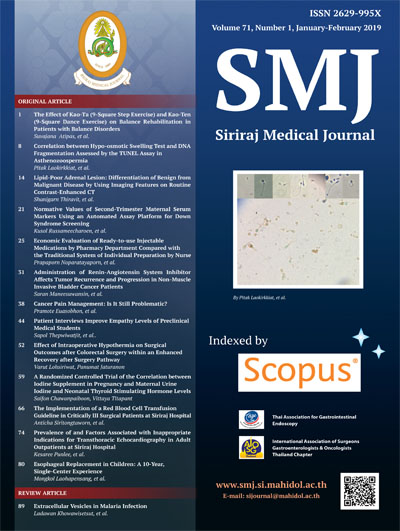Esophageal Replacement in Children: A 10-Year, Single-Center Experience
DOI:
https://doi.org/10.33192/Smj.2019.13Keywords:
Esophageal replacement; isoperistaltic gastric tube; reversed gastric tube; gastric transposition; colonic interpositionAbstract
Objective: Various esophageal replacement grafts have been used in children, although none can equal the native
esophagus. The purpose of this study was to review the complications and outcomes associated with using different
techniques in a single institute.
Methods: A retrospective medical record review was conducted from 2006 to 2016. Patient demographics, perioperative
clinical courses, complications and long-term outcomes were reported as percentages and categorized according
to the surgical procedure performed.
Results: A total of 15 children underwent esophageal replacement procedures, comprising 7 (47%) isoperistaltic
gastric tubes, 3 (20%) colonic interpositions, 3 (20%) gastric transpositions and 2 (13%) reversed gastric tubes.
Indications for esophageal replacement included long-gap esophageal atresia (5; 33%), esophageal atresia with
severe postoperative complications (6; 40%), and caustic injury (4; 27%).The mean age of patients was 2.9 years
(range: 0.2–15 years). The average follow-up duration was 3.6 years (range: 0.4–8 years). There was no perioperative
mortality and no graft loss in any group. The long-term outcomes were acceptable, with no late stricture. Eightysix
percent of the patients in the isoperistaltic gastric tube group and all patients in the other procedural groups
achieved full oral feeding. Nevertheless, the patients had various degrees of malnutrition.
Conclusion: Esophageal replacement remains a major challenge in children. Our experience indicates that children
can be safely operated on using any of these methods, with acceptable outcomes and no deaths. Nevertheless, the
long-term consequences and complications should be monitored throughout adulthood.
Downloads
Published
How to Cite
Issue
Section
License
Authors who publish with this journal agree to the following conditions:
Copyright Transfer
In submitting a manuscript, the authors acknowledge that the work will become the copyrighted property of Siriraj Medical Journal upon publication.
License
Articles are licensed under a Creative Commons Attribution-NonCommercial-NoDerivatives 4.0 International License (CC BY-NC-ND 4.0). This license allows for the sharing of the work for non-commercial purposes with proper attribution to the authors and the journal. However, it does not permit modifications or the creation of derivative works.
Sharing and Access
Authors are encouraged to share their article on their personal or institutional websites and through other non-commercial platforms. Doing so can increase readership and citations.














